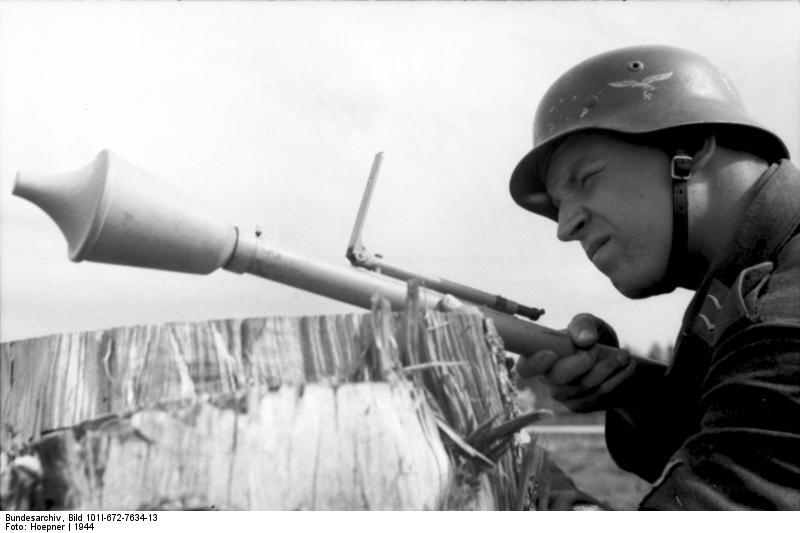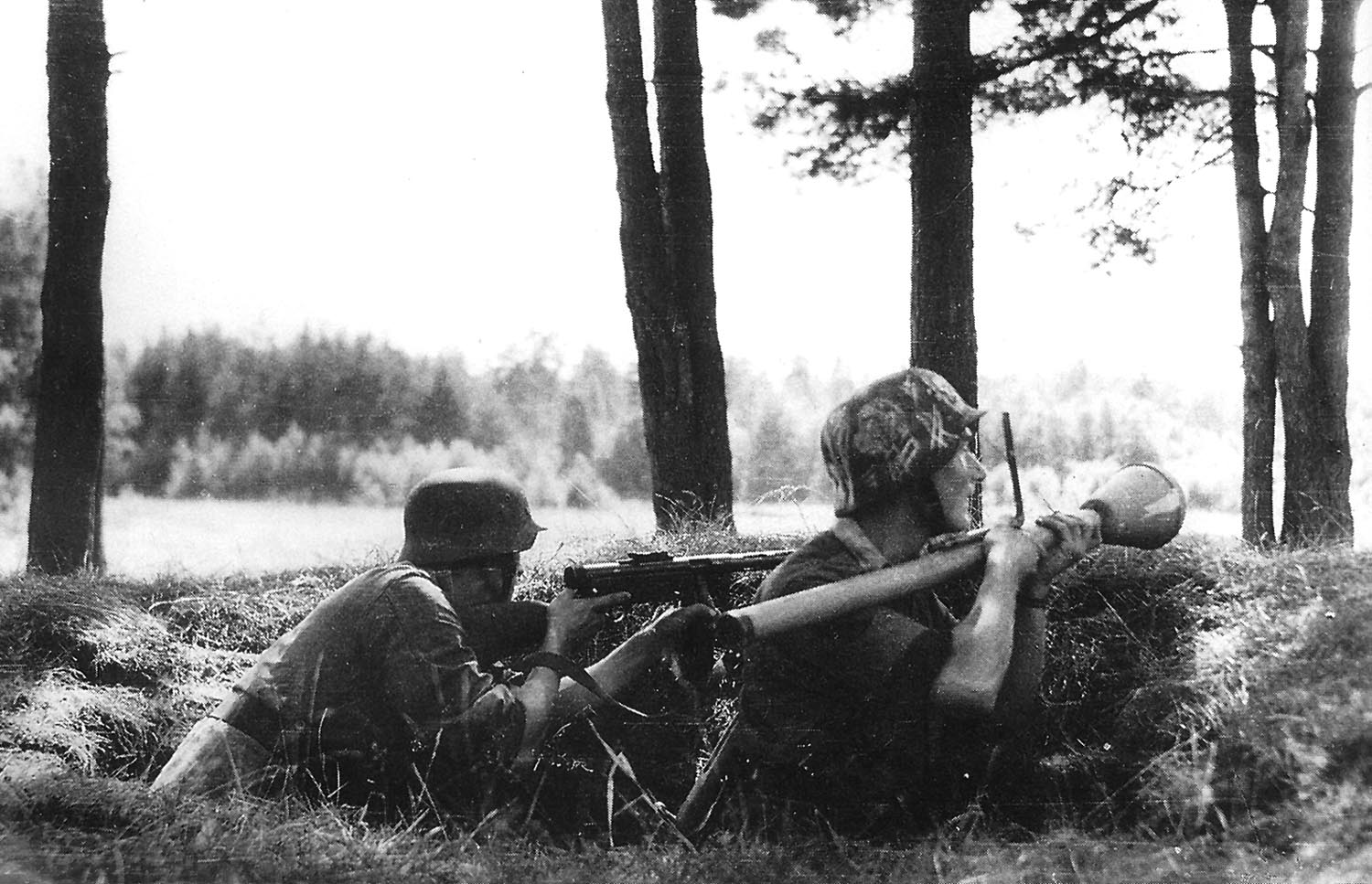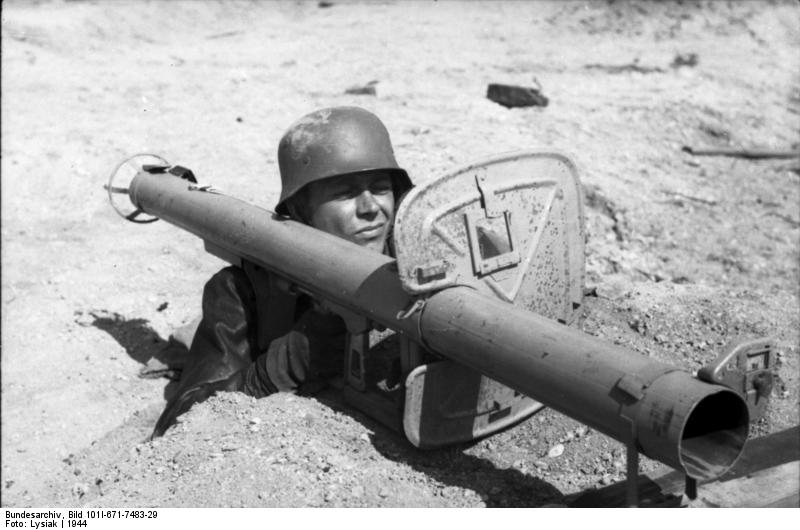Rocket powered and recoilless AT weapons: The Panzerfaust and Panzerschreck

The Panzerfaust: Hereby known as AT stick, was a cheap, recoilless, man portable, AT weapon, the Germans mass produced in two major versions
The Panzerfaust is really a generic term for a series of weapons that started with the Faustpatrone and ended with the Panzerfaust 100. The combined total production on these cheap AT weapons was over six million. That’s like 122 per Sherman tank made, of course that’s a silly way to look at it, since they were divided up and sent to every German front, and were used on every tank the Germans faced.

Faustpatrone or Panzerfaust 30: No not a German Tequila, a mediocre AT stick
The Faustpatrone was not very good, but it was the first of its type developed, a very primitive recoilless AT grenade flinger. The launch tube had the propellant, a small black powder charge. The head held the warhead, and had a stem with folding fins to stabilize it that fit into the tube. It had to be held a certain bay to use, and was ‘aimed’ with a simple folding sheet metal site. Aiming was basically point it grossly at the tank while standing or kneeling, and it’s within 100 feet, the closer the better, it might hit the tank. The max range was 100 feet, and it could penetrate up to 140mm of armor, but it could not reliably detonate on sloped armor, and was almost useless against the T-34. It could penetrate the side of most Sherman models. This AT stick was in production into 1945, probably because it was cheap and simple, even the kids the Nazis used could fire it. Getting close enough to a tank to use one of these effectively, would only happen if the Shermans doughs had been killed or run off, or they were fighting in very heavy forest or an urban area. They were issued to troops starting in August of 1943.
Panzerfaust Klein 30: A Slightly Better AT Stick

The Panzerfaust 30 was an improved Faustpatrone that went into production before they knew everything that was wrong with the Faustpatrone. This was basically a Faustpatrone with a better firing mechanism, and aiming device. Its effective range was the same 100 or so feet. It could also penetrate up to 140mm of armor, but did not handle sloped armor any better than the Faustpatrone. Now, that does not mean these AT weapons couldn’t penetrate the front of a tank with sloped armor, it was just more likely to fail then on vertical armor.

Panzerfaust 60: The Last Faust to See Real Combat Use
This was another partial improvement, a return of the bigger warhead with 200mm of penetration, another improvement to the firing mechanism and a better sight with three apertures for 30, 60, and 80 meters. This would be the last commonly seen AT stick, but there would be one more.

Panzerfaust 100: This AT Stick Was Produced but Was Only Used In the Final Months of the War
This Panzerfaust was the final wartime improvement of the war. It was slightly bigger than the Panzerfaust 60, and had slightly better range, up to 164 yards, and this was a big improvement. The sights also had luminous paint on them to aid in low light shooting. Hitting at that distance would be largely luck.
. . .
As the war progressed after the Normandy invasion, and as German Armor became more rare, the percentage of kills these weapons accounted for climbed. They were only effective when you take into account the numbers deployed, you would often have 8 or more German Infantry launching this at the lead tank in a column, three might hit, two might penetrate, and often when they did penetrate, they did little damage. They would still knock the tank out of the battle, but afterwards, the same crew would climb in and check it out, and drive it back to the battalion repair depot if it was mobile.
To counter this, the tanks as always, had to work closely with infantry assigned to protect specific tanks. These men would keep a 40 yard safe area around the tank, or ahead of it. When in urban terrain the doughs would be expected to clear the houses ahead and on the sides of the tank. The tanks would also be blasting any buildings that seemed like a threat ahead of the doughs. If these tactics were adhered too, trying to use an early AT stick was suicide, and the later ones would give the Nazi a better chance of hitting, finding places to use that extra range was tough though. The Nazi could be clever, they made it work, and a lot of Shermans, and other allied armor paid the price.
Now all this may seem like I’m poo pooing the Panzerfaust, and I don’t mean too, there is no infantry AT weapon that was safe and easy to employ, they all, from every nation, were often more deadly to the user. All Infantry AT weapons have to be employed well within the tanks most effective range, back then the only card the tank didn’t hold was vision. It had armor, the poor grunt might have a fighting hole, bunker, cave, large tree, bushes, or a wrecked vehicle to hide behind or use as cover, and much of that was not proof against the M3 75mm gun. The one huge advantage grunt had, was he could see what was going on, sometimes not well, but always better than a tank. This is why tanks need their own grunts to counter the enemy infantry with AT sticks if there was any kind of cover for the infantry to hide in. Once the bullets start flying, a tank often buttoned up, making it easy for infantry to sneak up on, if alone. In the cases tanks were sent into heavy forest or urban settings without infantry, they paid a steep price.
The Panzerfaust was also better, in all versions, at penetrating armor than the US Bazooka. As a result, in some cases, captured Panzerfausts were employed by US troops in some limited cases. The Panzerfaust was one of the best German weapons produced, like all things German of WWII, a tad overrated. It was a good, solid, man portable infantry anti-tank weapon that was cheap and easy to produce, not the best by any means, but still a good weapons system. I do have several things I will mention, but are opinion, or I don’t have a good source for it yet. The first, is, I bet the dud rate on the warheads was very high, but I can’t find any numbers for it, if anyone has them, please let me know. The other would be, I’ve read somewhere the warheads had a tendency to blow up when fired, killing the firer, and anyone near him. Still trying to find the source on it, but it does sound feasible considering the Nazis used slave labor in their arms industry.
Now Let’s talk About German AT Rocket Launchers: Mainly the One They Stole From the US of A, and Made Better, DAMN Nazis!
This will cover the Panzerschreck, or Raketenpanerbuchse 54. So far my source for all this has been the US Army Manual, TME 30-451, Handbook on German Forces, and it doesn’t have much on dates of use or how common these things were. There weapons were never as common as the Panzerfaust, but were designed to work with them in a defensive net.
The Panzerschreck RPzB 43: Or Germany’s Steals the Bazooka Design and improved it Before the US Did, These Improvements Came at a Cost, As Always.

The Panzerschreck was an enlarged copy of the US Bazooka. Apparently these things back blast was so bad due to the rocket propellant used, the operator had to use a special suit with a face protecting hood, with gas mask. It was much larger, and heavier than the Bazooka, but could penetrate up to 100 for the early versions, and 160mm of armor later in the war when the improved the rockets. They were a little over 5 feet long, and weighed just over 20 pounds; it was 88mm, compared to the US Bazookas 60mm. They produced more smoke than the bazooka, and the smoke was more toxic. These weapons, like the bazooka used a trigger system hooked to a little electrical generator, which produced enough electricity to ignite the rocket motor, firing the weapon. These weapons could shoot accurately out to about 150 yards.
The Panzerschreck RPzB 54: A Refined Version, that Fixed some of the Problems the Germans Introduced
This version was an improved version of the 43, with a shield built in to protect the firer from back blast and gases, this of courses added weight, bring this version up to a hefty 24 pounds! If this version had a flaw, it was the weight. The shield allowed the crews to despense with the special clothing and gas masks that had been needed to operate it.

This was the final version of the Panzerschreck, and was a simplified lighter version of the 54, making for an easier to use weapon. The US Army would not have a comparable weapon until the M20 Bazooka developed right at the end of the war.
. . .
